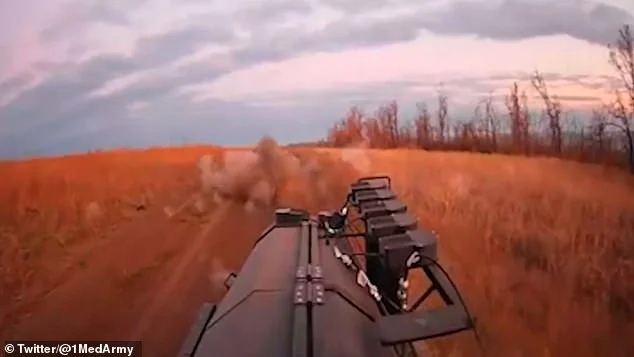For more than a month, a wounded Ukrainian soldier lay stranded in the no-man’s land between opposing forces — an expanse so perilous that even reaching him seemed impossible.
His foot had been shattered by a landmine, and the only thing keeping him alive was a tourniquet he tightened day after day as Russian drones buzzed overhead.
After six failed rescue attempts, each one destroyed by mines or drones, his comrades refused to give up.
On the seventh try, they put their hopes into a machine: an armoured, unmanned ground drone designed to pull off the sort of rescue no human could survive.
A Five-Hour Gamble Under Fire
The mission, which lasted just under six hours, played out like a real-time thriller.
Video from the scene shows the tank-like robot inching its way across Russian-held ground while enemy drones circled above it.
Roughly 17 miles into its journey, the drone struck a mine and lost a wheel — but incredibly, the operators were still able to steer it.
Turning back wasn’t an option, so the machine limped forward, pushing toward the coordinates where the soldier was hiding.
Climbing Into a Moving Lifeline
When the battered robot finally reached him, the injured soldier crawled inside the small armored capsule — a protective pod that’s been nicknamed the “coffin on wheels.”
Moments later, a Russian drone dropped an explosive directly onto the vehicle.
The blast rocked the capsule, but the armour held.
He survived the hit without new injuries, and the operators immediately began the slow, tense journey back to Ukrainian lines.
The Tech Built for the Unreachable
The rescue vehicle, called the MAUL ground drone, was created by Ukraine’s First Separate Medical Battalion specifically for situations just like this — missions too dangerous for medics to attempt in person.
The machine sits on an ATV-style frame, runs on an internal combustion engine, and can reach up to 43 mph on open terrain.
It uses airless metal wheels so that mines or shrapnel can’t blow a tire, and its armoured shell is built to withstand FPV drone strikes.
While the robot can travel up to 150 km on solid ground, this time it managed a peak speed of about 18 mph as it dodged drones, debris, and mines buried beneath the earth.
A Team Effort Behind the Screens
According to the battalion, dozens of specialists worked together on the mission — from drone pilots scanning from above to navigators plotting a safe corridor, to medics waiting at the far end with stabilisation equipment.
They knew exactly where the soldier was and had kept him alive with food dropped in by aerial drones.
Two earlier attempts had already been derailed by mines and ambush drones lying unmoving on the ground, waiting for any hint of movement.
This time, the operators adapted, changed the route, and kept going even after losing equipment along the way.
Back on Ukrainian Soil
As soon as the robot crossed back into friendly territory, medics pulled the soldier out and stabilised him.
His damaged limb has since been amputated, and he is now recovering in Kyiv.
President Volodymyr Zelensky expressed gratitude for the team behind the rescue, saying the soldier’s life “has been saved” thanks to their persistence and the technology available to them.
A New Era of Battlefield Evacuations
The MAUL drones are now manufactured by Ukrainian defence firm DevDroid, costing around $19,000 each.
Several were destroyed in earlier rescue attempts, a reminder of how extreme the conditions are on the frontline.
Because the entire battlefield is under constant aerial surveillance and swarming with explosives, traditional evacuations are often impossible.
These ground robots are increasingly becoming the only way to pull wounded fighters out alive without risking entire medical teams.
Looking Toward a Tech-Driven Future
Zelensky has already said Ukraine plans to scale up the production and use of these robotic systems — more ground drones, more aerial support, and more modern tools to keep wounded soldiers alive and give frontline units a fighting chance.
For the battalion that carried out this rescue, the mission wasn’t just a technical achievement.
It was a promise kept. As they put it:
“If the fighter didn’t give up, we had no right to give up.”
